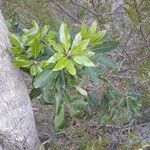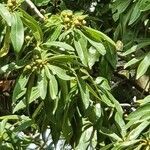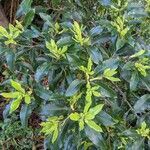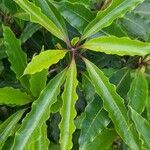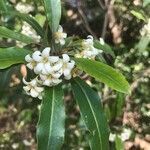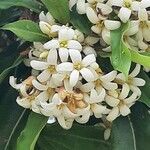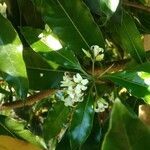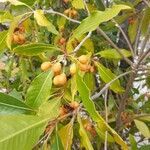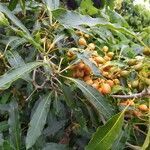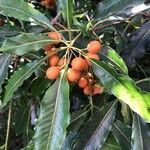Tree 5–13 m high, with a rounded canopy; bark dark grey, fissured, new stems with cuticular ridging, glabrous, grey. Cotyledons with glandular and short-base T-shaped hairs, elliptic, c. 14 mm long and 6 mm wide, apices acute, distinctly petiolate. Seedling leaves immediately alternate, almost trilobed margins rapidly entire, elliptic to obovate. Adult leaves whorled; lamina elliptic, 90–120 mm long, 30–45 mm wide, cuneate, undulate, small drip tip, upper surface glossy green, lower surface paler, both surfaces glabrous; petiole 16–26 mm long. Inflorescences terminal, umbels of three flowers, floral axes protected by up to 4 layers of overlapping bracts; pedicels angular, ridged more than about 10 mm long with small, caducous bracteoles. Sepals 8–10 mm long, mostly cupular, cohering to the middle but totally separated on one side, then acuminate, spreading recurved, margins hairy. Petals almost linear, clawed, cohering in throat, blade recurved, cream, aromatic. Male flowers more numerous and generally longer (12–18 mm) than female flower; anthers noticeably exserted, sagittate but with a very shallow basal sinus, yellow; filaments much longer than anthers, tapering from a wide base, white. Pistil can appear cryptically perfect with the ovary and style both about 4 mm long, the ovary with nil or few ovules. Although dioecious, most male plants produce the occasional fruit. Female flowers are fewer (less branching) shorter and fatter (12–14 mm); stamens can range from vestigial staminodes without anthers, to shrivelled anthers barely reaching the style base that may or may not be capable of producing pollen, not exserted. Stigma lobed-capitate; style shorter than ovary, thick; ovary fat, globose, hairy, 4–5 mm long, incompletely (tri-) bi-locular with numerous ovules; basal nectary present. Fruit a dehiscent capsule, globuse, 10–12 mm long, 10–15 mm diam., orange-yellow when mature, inner yellow; apices heart-shaped; seeds numerous, red-brown, slightly glandular, cohering.
More
An evergreen shrub or small tree. It grows 14 m tall. The crown is dense. The bark is smooth and grey. The leaves are alternate and crowded at the ends of the branches. They are narrowly oval or sword shaped and shiny green. The edges are wavy. The flowers are in groups at the ends of the branches. They are white and have a scent. The fruit is an orange capsule. It is 1.6 cm long and has 25 angular seeds.
Tree or shrub, 3-6 m high. Leaves dark green, margins distinctly undulate. Inflorescences terminal, umbellate-paniculate, few-flowered, ± 12 mm long. Flowers white, larger than that of indigenous species. Sepals > 5 mm long, connate in lower 1/2 in a spathe, finally slit on one side, with subulate, hairy lobes bent out. Flowering time Nov.?.
Grown as an ornamental and shelter plant. A horticultural form with white-variegated leaves is available. This form differs from the commonly cultivated variegated forms of the New Zealand endemic Pittosporum eugenioides which has tiny, insignificant maroon flowers, and numerous, very small (less than 8 mm in diam.) globose, green fruits. The hybrid with Pittosporum bicolor is a tall rounded tree with flowers like P. undulatum and leaves like P. bicolor. Several very large specimens are growing in the Pittosporaceae bed in the Australian National Botanic Gardens. Pittosporum undulatum subsp. × emmettii
More
The seeds are roasted and then eaten. Sometimes they are crushed.
